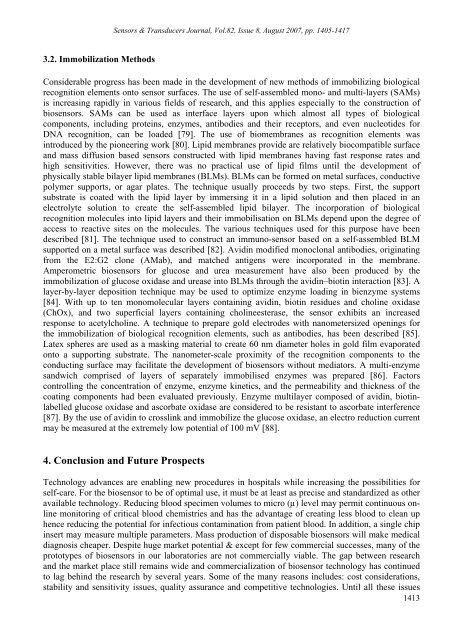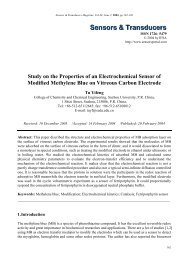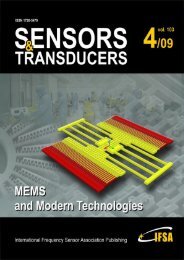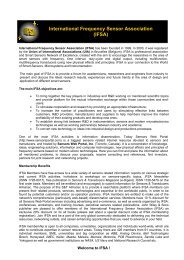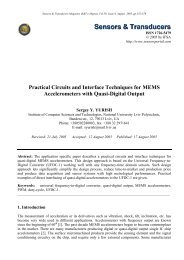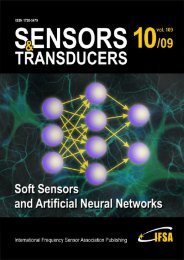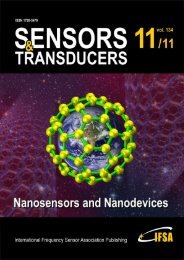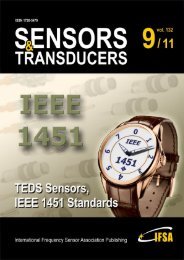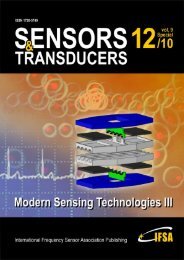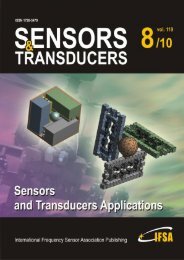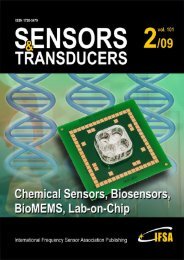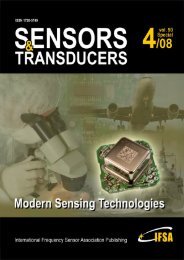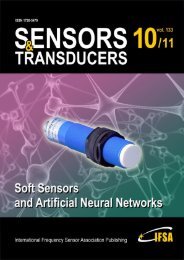Bio-Techniques in Electrochemical Transducers: an Overview
Bio-Techniques in Electrochemical Transducers: an Overview
Bio-Techniques in Electrochemical Transducers: an Overview
Create successful ePaper yourself
Turn your PDF publications into a flip-book with our unique Google optimized e-Paper software.
3.2. Immobilization Methods<br />
Sensors & <strong>Tr<strong>an</strong>sducers</strong> Journal, Vol.82, Issue 8, August 2007, pp. 1405-1417<br />
Considerable progress has been made <strong>in</strong> the development of new methods of immobiliz<strong>in</strong>g biological<br />
recognition elements onto sensor surfaces. The use of self-assembled mono- <strong>an</strong>d multi-layers (SAMs)<br />
is <strong>in</strong>creas<strong>in</strong>g rapidly <strong>in</strong> various fields of research, <strong>an</strong>d this applies especially to the construction of<br />
biosensors. SAMs c<strong>an</strong> be used as <strong>in</strong>terface layers upon which almost all types of biological<br />
components, <strong>in</strong>clud<strong>in</strong>g prote<strong>in</strong>s, enzymes, <strong>an</strong>tibodies <strong>an</strong>d their receptors, <strong>an</strong>d even nucleotides for<br />
DNA recognition, c<strong>an</strong> be loaded [79]. The use of biomembr<strong>an</strong>es as recognition elements was<br />
<strong>in</strong>troduced by the pioneer<strong>in</strong>g work [80]. Lipid membr<strong>an</strong>es provide are relatively biocompatible surface<br />
<strong>an</strong>d mass diffusion based sensors constructed with lipid membr<strong>an</strong>es hav<strong>in</strong>g fast response rates <strong>an</strong>d<br />
high sensitivities. However, there was no practical use of lipid films until the development of<br />
physically stable bilayer lipid membr<strong>an</strong>es (BLMs). BLMs c<strong>an</strong> be formed on metal surfaces, conductive<br />
polymer supports, or agar plates. The technique usually proceeds by two steps. First, the support<br />
substrate is coated with the lipid layer by immers<strong>in</strong>g it <strong>in</strong> a lipid solution <strong>an</strong>d then placed <strong>in</strong> <strong>an</strong><br />
electrolyte solution to create the self-assembled lipid bilayer. The <strong>in</strong>corporation of biological<br />
recognition molecules <strong>in</strong>to lipid layers <strong>an</strong>d their immobilisation on BLMs depend upon the degree of<br />
access to reactive sites on the molecules. The various techniques used for this purpose have been<br />
described [81]. The technique used to construct <strong>an</strong> immuno-sensor based on a self-assembled BLM<br />
supported on a metal surface was described [82]. Avid<strong>in</strong> modified monoclonal <strong>an</strong>tibodies, orig<strong>in</strong>at<strong>in</strong>g<br />
from the E2:G2 clone (AMab), <strong>an</strong>d matched <strong>an</strong>tigens were <strong>in</strong>corporated <strong>in</strong> the membr<strong>an</strong>e.<br />
Amperometric biosensors for glucose <strong>an</strong>d urea measurement have also been produced by the<br />
immobilization of glucose oxidase <strong>an</strong>d urease <strong>in</strong>to BLMs through the avid<strong>in</strong>–biot<strong>in</strong> <strong>in</strong>teraction [83]. A<br />
layer-by-layer deposition technique may be used to optimize enzyme load<strong>in</strong>g <strong>in</strong> bienzyme systems<br />
[84]. With up to ten monomolecular layers conta<strong>in</strong><strong>in</strong>g avid<strong>in</strong>, biot<strong>in</strong> residues <strong>an</strong>d chol<strong>in</strong>e oxidase<br />
(ChOx), <strong>an</strong>d two superficial layers conta<strong>in</strong><strong>in</strong>g chol<strong>in</strong>eesterase, the sensor exhibits <strong>an</strong> <strong>in</strong>creased<br />
response to acetylchol<strong>in</strong>e. A technique to prepare gold electrodes with n<strong>an</strong>ometersized open<strong>in</strong>gs for<br />
the immobilization of biological recognition elements, such as <strong>an</strong>tibodies, has been described [85].<br />
Latex spheres are used as a mask<strong>in</strong>g material to create 60 nm diameter holes <strong>in</strong> gold film evaporated<br />
onto a support<strong>in</strong>g substrate. The n<strong>an</strong>ometer-scale proximity of the recognition components to the<br />
conduct<strong>in</strong>g surface may facilitate the development of biosensors without mediators. A multi-enzyme<br />
s<strong>an</strong>dwich comprised of layers of separately immobilised enzymes was prepared [86]. Factors<br />
controll<strong>in</strong>g the concentration of enzyme, enzyme k<strong>in</strong>etics, <strong>an</strong>d the permeability <strong>an</strong>d thickness of the<br />
coat<strong>in</strong>g components had been evaluated previously. Enzyme multilayer composed of avid<strong>in</strong>, biot<strong>in</strong>labelled<br />
glucose oxidase <strong>an</strong>d ascorbate oxidase are considered to be resist<strong>an</strong>t to ascorbate <strong>in</strong>terference<br />
[87]. By the use of avid<strong>in</strong> to crossl<strong>in</strong>k <strong>an</strong>d immobilize the glucose oxidase, <strong>an</strong> electro reduction current<br />
may be measured at the extremely low potential of 100 mV [88].<br />
4. Conclusion <strong>an</strong>d Future Prospects<br />
Technology adv<strong>an</strong>ces are enabl<strong>in</strong>g new procedures <strong>in</strong> hospitals while <strong>in</strong>creas<strong>in</strong>g the possibilities for<br />
self-care. For the biosensor to be of optimal use, it must be at least as precise <strong>an</strong>d st<strong>an</strong>dardized as other<br />
available technology. Reduc<strong>in</strong>g blood specimen volumes to micro (µ) level may permit cont<strong>in</strong>uous onl<strong>in</strong>e<br />
monitor<strong>in</strong>g of critical blood chemistries <strong>an</strong>d has the adv<strong>an</strong>tage of creat<strong>in</strong>g less blood to cle<strong>an</strong> up<br />
hence reduc<strong>in</strong>g the potential for <strong>in</strong>fectious contam<strong>in</strong>ation from patient blood. In addition, a s<strong>in</strong>gle chip<br />
<strong>in</strong>sert may measure multiple parameters. Mass production of disposable biosensors will make medical<br />
diagnosis cheaper. Despite huge market potential & except for few commercial successes, m<strong>an</strong>y of the<br />
prototypes of biosensors <strong>in</strong> our laboratories are not commercially viable. The gap between research<br />
<strong>an</strong>d the market place still rema<strong>in</strong>s wide <strong>an</strong>d commercialization of biosensor technology has cont<strong>in</strong>ued<br />
to lag beh<strong>in</strong>d the research by several years. Some of the m<strong>an</strong>y reasons <strong>in</strong>cludes: cost considerations,<br />
stability <strong>an</strong>d sensitivity issues, quality assur<strong>an</strong>ce <strong>an</strong>d competitive technologies. Until all these issues<br />
1413


